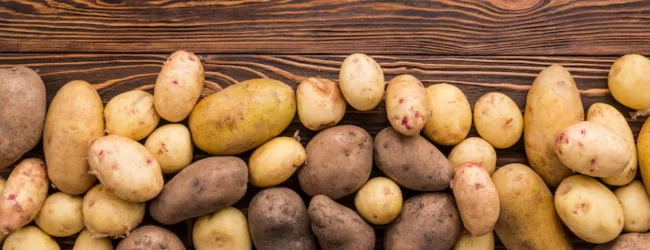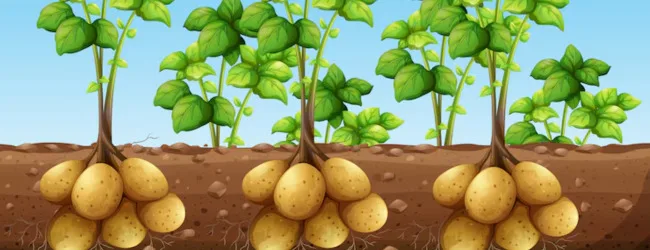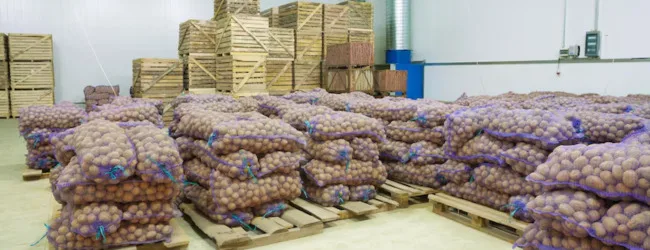Table of contents
Potato farming is a significant agricultural practice worldwide, providing a staple food source for billions of people. Understanding the essential requirements, favorable conditions, and effective techniques is crucial for successful potato cultivation and maximizing yields. This comprehensive guide will delve into the key aspects of potato farming, from selecting the right varieties to implementing modern agricultural practices. Whether you are a seasoned farmer or a beginner looking to grow potatoes, this information will equip you with the knowledge needed for a thriving potato harvest.
Potato Varieties in Brief

The world of potatoes is incredibly diverse, with numerous varieties each possessing unique characteristics suitable for different climates, soil types, and culinary uses. Here are a few popular potato varieties:
- Russet Burbank: Known for its oblong shape, rough brown skin, and white flesh, it’s a popular choice for baking and French fries.
- Yukon Gold: Characterized by its smooth, thin yellow skin and yellow flesh, it offers a slightly sweet and buttery flavor, excellent for boiling, mashing, and roasting.
- Red Pontiac: Easily recognizable by its smooth red skin and white flesh, it’s a good all-purpose potato, often used for boiling and salads.
- Kennebec: A versatile variety with smooth white skin and white flesh, known for its high yield and suitability for chipping and baking.
- Fingerling Potatoes (e.g., Russian Banana, French Fingerling): Small, elongated potatoes with firm texture and distinct flavors, often used in salads and gourmet dishes.
Choosing the right variety depends on your local climate, soil conditions, market demand, and intended use of the potatoes.
Favorable Conditions to Grow
Potatoes thrive in specific environmental conditions. Understanding and providing these conditions will significantly impact the success of your potato crop:
- Climate: Potatoes prefer cool growing seasons with moderate temperatures, ideally between 15°C and 24°C (60°F and 75°F). High temperatures, especially during tuber development, can negatively affect yield and quality. They are typically grown as a spring or fall crop in many regions to avoid extreme heat.
- Sunlight: Potatoes need at least 6-8 hours of direct sunlight per day for optimal photosynthesis and tuber development. Insufficient sunlight can lead to smaller tubers and reduced yields.
- Water: Consistent moisture is crucial, especially during tuber initiation and bulking. However, waterlogged soils can lead to rot and disease. Aim for well-drained soil and provide regular irrigation, especially during dry periods. The specific water requirements will vary depending on the climate, soil type, and growth stage.
- Soil: The ideal soil for potato farming is loose, well-drained, and rich in organic matter. Sandy loam or silt loam soils are generally preferred as they allow for good aeration and drainage, which are essential for healthy tuber development. Heavy clay soils can become waterlogged and hinder tuber growth. The soil pH should ideally be between 5.0 and 6.5.
Soil Preparation
Proper soil preparation is a foundational step in successful potato farming. It ensures a favorable environment for root and tuber development:
- Clearing the Land: Remove any weeds, rocks, and debris from the planting area. These obstacles can hinder growth and make harvesting difficult.
- Tilling or Ploughing: Loosen the soil to a depth of at least 20-30 cm (8-12 inches). This improves aeration, drainage, and allows the potato tubers to expand easily.
- Adding Organic Matter: Incorporate compost, well-rotted manure, or other organic matter into the soil. This improves soil structure, water retention, and nutrient availability. Aim for a good distribution of organic matter throughout the planting area.
- Soil Testing: Conduct a soil test to determine the nutrient levels and pH. This will help you identify any deficiencies and adjust the soil accordingly with appropriate fertilizers.
- Creating Raised Beds or Hills: In many regions, potatoes are planted in raised beds or hills. This further improves drainage and provides more loose soil for tuber development. The rows are typically spaced 75-90 cm (30-36 inches) apart, and the hills or beds are created within the rows.
Planting Seed Potatoes

Potatoes are typically grown from “seed potatoes,” which are small, disease-free potato tubers with visible sprouts (“eyes”).
- Selecting Seed Potatoes: Choose certified disease-free seed potatoes from reputable suppliers. Avoid using potatoes from your previous harvest as they may carry diseases. Select seed potatoes of the desired variety and size (typically 30-60 grams or 1-2 ounces).
- Chitting (Sprouting): About 4-6 weeks before planting, place the seed potatoes in a cool, bright, and frost-free location to encourage sprouting. This process, called chitting, gives the plants a head start and can lead to earlier and more uniform emergence.
- Cutting Seed Potatoes (Optional): Larger seed potatoes can be cut into pieces, ensuring each piece has at least one or two healthy sprouts. Allow the cut surfaces to dry and suberize (form a protective layer) for a day or two before planting to prevent rot.
- Planting: Plant the seed potatoes at a depth of about 10-15 cm (4-6 inches) in the prepared soil, with the sprouts facing upwards. Space the seed potatoes within the rows about 25-30 cm (10-12 inches) apart.
💡 Pro Tip: If you want to start farming but have too many doubts, connect with a farming expert from Boss Wallah for guidance – https://bw1.in/1116
Growing and Maintenance
Once the potatoes are planted, consistent care is essential for healthy growth and a good yield:
- Hilling: As the potato plants grow, mound soil around the base of the stems, covering the developing tubers. This process, called hilling, protects the tubers from sunlight (which can cause them to turn green and produce solanine, a toxic compound), provides support to the growing plants, and encourages the development of more tubers along the buried stem. Hilling is typically done several times as the plants grow, starting when they are about 15-20 cm (6-8 inches) tall.
- Weed Control: Regularly remove weeds that compete with the potato plants for water, nutrients, and sunlight. Manual weeding or shallow cultivation can be effective. Be careful not to damage the developing tubers during cultivation. Mulching with straw or other organic materials can also help suppress weed growth and retain soil moisture.
- Watering: Maintain consistent soil moisture, especially during flowering and tuber development. Avoid overwatering, which can lead to diseases. Water deeply and less frequently rather than shallowly and often. The frequency of watering will depend on the weather conditions and soil type.
- Fertilization: If the soil test indicates nutrient deficiencies, apply appropriate fertilizers. Potatoes need nitrogen for vegetative growth, phosphorus for root and tuber development, and potassium for overall plant health and tuber quality. Apply fertilizers according to the soil test recommendations and the growth stage of the plants. Side-dressing with fertilizer during the growing season may also be beneficial.
- Pest and Disease Management: Monitor the plants regularly for signs of pests and diseases. Common potato pests include Colorado potato beetles, aphids, and potato leafhoppers. Common diseases include early blight, late blight, and scab. Implement integrated pest management (IPM) strategies, which may include cultural practices (e.g., crop rotation, using disease-resistant varieties), biological control (e.g., introducing beneficial insects), and chemical control (using pesticides as a last resort).
ALSO READ | Different Types of Farming: Top Sustainable Practices for 2025
Harvesting Potatoes
The timing of potato harvest depends on the variety and intended use.
- Early Potatoes (New Potatoes): These are harvested when the plants are still flowering or shortly after, typically 70-80 days after planting. The tubers are small, have thin skin, and are often enjoyed boiled or roasted.
- Main Crop Potatoes: These are harvested when the foliage starts to turn yellow and die back, usually 90-120 days after planting. The skins are thicker, and the tubers are mature and suitable for storage.
- Harvesting Technique: Carefully dig up the potatoes using a digging fork or potato harvester, being careful not to damage the tubers. Allow the harvested potatoes to dry on the soil surface for a few hours to cure the skin, which helps prevent bruising and rot during storage.
Storing Potatoes

Proper storage is essential for extending the shelf life of your harvested potatoes.
- Curing: After harvesting, cure the potatoes in a cool, dark, and well-ventilated place for about two weeks at a temperature of 10-15°C (50-60°F) and high humidity (85-90%). This allows the skins to harden and any minor bruises to heal.
- Storage Conditions: Store cured potatoes in a cool (4-10°C or 40-50°F), dark, and well-ventilated place with high humidity (85-90%). Avoid storing potatoes near apples or onions, as they release ethylene gas, which can cause potatoes to sprout prematurely.
- Sorting: Before storing, sort the potatoes and remove any damaged or diseased tubers to prevent spoilage from spreading.
Need Expert Guidance?
Starting a business can be challenging, but you don’t have to do it alone! At Boss Wallah, our 2,000+ business experts are ready to provide valuable insights and guidance. Whether you need help with marketing, finance, sourcing, or any other area of any business, our business experts are here to help you succeed: https://bw1.in/1116
Confused about Which Business to Start?
Want to start your own business but unsure which one to choose? Explore Boss Wallah, where you’ll find 500+ courses by successful business owners, featuring practical, step-by-step guides on starting and growing various businesses.
Find your perfect business idea today: https://bw1.in/1111
Conclusion
Potato farming, while seemingly simple, requires careful planning, attention to detail, and consistent effort. By understanding the specific requirements of different potato varieties, providing favorable growing conditions, implementing proper soil preparation and planting techniques, and diligently managing the crop throughout its growth cycle, you can significantly increase your chances of a bountiful and high-quality potato harvest. From selecting the right seed potatoes to ensuring proper storage, each step plays a crucial role in the overall success of your potato farming endeavor.
Frequently Asked Questions (FAQs)
- What is the best time of year to plant potatoes?
- The best time to plant potatoes depends on your local climate. Generally, plant early varieties in early spring after the last frost and main crop varieties from late spring to early summer. In regions with mild winters, a fall planting for a winter or early spring harvest may also be possible.
- How deep should I plant seed potatoes?
- Plant seed potatoes about 10-15 cm (4-6 inches) deep. This depth provides adequate soil cover for tuber development and protection from sunlight.
- Why are my potato plants flowering?
- Flowering is a natural part of the potato plant’s growth cycle. While flowers themselves don’t directly produce tubers, they indicate that the plant is mature enough to start tuber development. Some varieties flower more profusely than others.
- How often should I water my potato plants?
- Water deeply and regularly, especially during dry periods and during tuber initiation and bulking. The frequency will depend on the soil type and weather conditions. Aim to keep the soil consistently moist but not waterlogged.
- What causes potato tubers to turn green?
- Exposure to sunlight causes potato tubers to produce chlorophyll (turning them green) and solanine, a toxic alkaloid. Hilling the soil around the plants helps prevent greening. Green potatoes should not be eaten.
- How do I know when my potatoes are ready to harvest?
- For early potatoes, harvest when the plants are flowering or shortly after. For main crop potatoes, wait until the foliage starts to turn yellow and die back. You can also dig up a test hill to check the size and maturity of the tubers.
- Can I grow potatoes in containers?
- Yes, potatoes can be successfully grown in containers as long as the container is large enough (at least 10 gallons) and provides good drainage. Use a well-draining potting mix and follow similar planting and care guidelines as for in-ground planting.
- What are common pests and diseases of potatoes?
- Common potato pests include Colorado potato beetles, aphids, and potato leafhoppers. Common diseases include early blight, late blight, and scab. Regular monitoring and appropriate pest and disease management strategies are essential.



